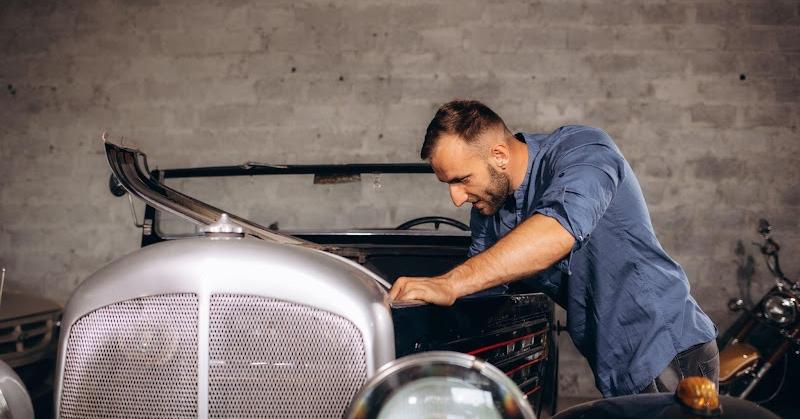Vintage automobile enthusiasts with an interest in restoration will find this article to be a valuable resource. Samuel Koran, an experienced restorer, offers guidance on many aspects of vintage car restoration. His coverage spans the allure of vintage vehicles, the step-by-step restoration process, considerations for selecting a car to restore, essential tools and equipment, recommendations, common challenges, cost aspects, and the rewarding experience of reviving a vintage automobile. This in-depth article by Samuel Koran caters to individuals of all skill levels in auto restoration, offering insightful information and expert guidance.
The History and Appeal of Vintage Cars
Vintage cars stand as icons of the past, prized by enthusiasts for their window into history. These antique machines attract gearheads with their lasting charm and masterful craftsmanship, each containing a unique story. More than just a way of transportation, classic cars serve as cultural representations of past eras.
Why People Are Drawn to Vintage Cars
The allure of vintage automobiles arises from their artistic elegance, exemplifying meticulous craftsmanship elements. Admirers are profoundly passionate, viewing vehicles as embodiments of heritage, preserving memorable moments in automobile development. Collectors’ dedication to preserving and reviving timeless machines highlights the lasting charm beyond financial value—evoking nostalgia and pride in rare parts, interior restoration, and exterior refining.
The Process of Automotive Restoration
Restoring vintage cars to their former glory requires expertise, skills, and specialized techniques to restore classic vehicles to their original condition. From rare parts to paint scheme replication, each phase demands precision and dedication to preventing rust, malfunctions, and decay—tests even for seasoned restorers. Gratification lies in observing once-forgotten vehicles gleam anew, preserving automotive history and evoking nostalgia for future generations.
Step-by-Step Guide to Restoring a Vintage Car
Initial examinations assess repairs from minor touch-ups to complete rebuilds. Focus first on refurbishing the outer shell, removing paint flakes to expose bare metal for sanding and priming to create a flawless form. Repairing upholstery requires intense care, removing dated fabrics, and fashioning the interior with quality materials honoring the original style.
Choosing the Right Car to Restore
Determining the right vintage automobile in need of restoration requires careful consideration of criteria like original aspects, modification options, and locating fittings. Each classic car offers a unique route to automotive history. Inspecting structural integrity lays the foundation for the entire process, as maintaining authenticity improves the work and protects historical importance. A thorough review of these pivotal factors ensures successful project completion.
Factors to Consider Before Starting a Restoration Project
Before starting a restoration project, one must carefully assess essential factors like the vehicle’s historical relevance, preservation level, and skills for specialized tasks such as metal fabrication, soldering, and refining. Exhaustive research and strategic planning are pivotal to determining suitable preservation methods. Understanding historical applications can recommend color palettes, surfaces, and material selections. Conservation techniques are essential to maintaining authenticity and ensuring the restoration respects historical value.
Tools and Equipment Needed for Restoration
Restoring vintage automobiles necessities specialized tools, equipment, access to valuable resources, and references. Acquiring these components is fundamental to attaining top-tier results and respecting the authentic design of the original vehicle. Regarding automotive restoration, having a wide assortment of tools is crucial. Precision measuring devices, torque wrenches, grinders, buffers, and socket wrench sets comprise a toolkit. For more complicated restorations, specialized machinery, including spray guns, welding machines, and engine hoists, are frequently needed for complex jobs. Access to these implements allows for meticulous work needed to restore such intricate machines.
Essential Tools for a Successful Restoration
Within automotive restoration, utilizing the guidance of seasoned professionals is imperative for achieving a successful project. Experts play a pivotal role in guiding novices through the intricate process of reviving classic cars by ensuring proper techniques are used. Their know-how aids in avoiding costly mistakes and ensures the restoration aligns with benchmarks maintained within the field. Adhering to best practices, such as industry-recognized detailing methods for tasks like compatible component selection, is paramount to fulfilling the standards of both owners and automotive enthusiasts.
Challenges and Common Roadblocks in Restoration
Restoration endeavors often present hardships and constraints that test a restorer’s patience and attention to detail. Overcoming these barriers is essential in the restoration process and leads to rewarding outcomes upon project completion. Those restoring regularly face issues like corrosion, mechanical failures, and uncommon parts.
How to Overcome Obstacles and Keep the Project on Track
Maintaining vigilance and dedication is paramount for overcoming obstacles and ensuring the triumphant conclusion of an automotive restoration. By skillfully using the appropriate tools and machines, those restoring can navigate hardships and stay on course. Adequate preparation involves dividing the restoration project into smaller, manageable tasks, establishing realistic schedules, and efficiently allocating resources.
The Cost of Automotive Restoration
The expenses of an automotive restoration can vary depending on several aspects, such as market demand, desired quality of craftsmanship, and finding original parts. It is crucial to consider these when starting a restoration project. Engaging in automotive restoration can be fulfilling, yet it demands prudent financial planning. A nuanced understanding of market demand for the particular make and model being restored is paramount, as it influences both total project costs and resale value potential. Thorough research into the availability and pricing of original components is critical for accurate budgeting.
Factors that Affect the Cost of Restoration
Numerous factors, like rust removal, sandblasting, and bodywork, influence the expense of refurbishing a vehicle. It is vital to carefully consider each step of the restoration process to budget the total costs. Removing rust is a significant phase in vehicle restoration. It involves the labor-intensive task of removing corroded metal. The complexity and time needed for rust removal can vary dramatically, affecting overall refurbishment costs. Bodywork in vehicle refurbishment involves dent repair, panel replacement, and ensuring structural integrity. These aspects are essential for the restored automobile’s aesthetics and functionality. Each step of the restoration process contributes to the overall cost and must be carefully managed to ensure a successful refurbishment within financial constraints.

